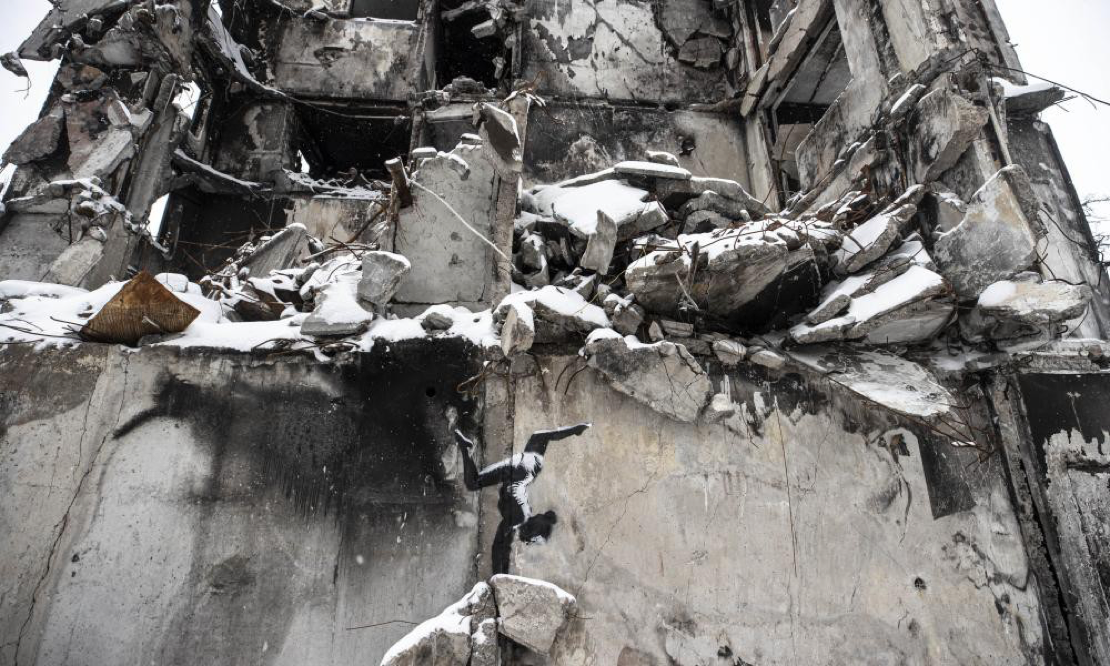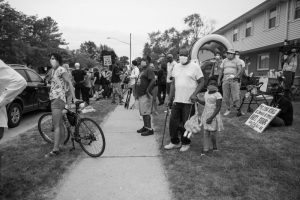Would-be thieves of Banksy graffito painted in ruins of war anticipated challenges facing those hoping to preserve it for nation’s future
A wide-ranging public discussion is taking place in Ukraine over what to do with seven street murals painted in November by the British artist Banksy on a series of destroyed buildings in and around Kyiv.
The conversation has grown urgent after thieves last month made off with one artwork from the town of Hostomel, about 15 miles (25km) outside the capital. It shows a woman in a gas mask and dressing gown holding a red fire extinguisher. She is standing next to a real flame-blackened window.
Banksy painted the image and six others during an unpublicised trip to Ukraine. He later acknowledged in a video that they were his work, done “in solidarity” with the Ukrainian people. The Instagram post showed the artist at work – his identity obscured – as well as interviews with local people walking amid ruins.
On 2 December, a group of men chiselled the dressing gown woman from the side of a scorched wall. When challenged by a local person, they claimed to be representatives of Neo-Eco, a French charity which is reconstructing the wrecked Hostomel housing estate using recycled materials.
Suspicious, the person rang the police. Officers arrived at the scene and arrested five men. The mural was recovered in good condition and is now being kept under guard at Hostomel’s police station. An investigation into the crime has been opened.
In a statement on Monday Ukraine’s prosecutor general’s office said the Kyiv man who allegedly organised the heist had been given a “suspicion notice”. If convicted, he faces up to 12 years in jail.
“Realising the value of the work, he planned to sell the graffiti and use the proceeds as he saw fit,” the office said. “For this, he involved men who were unaware of his intentions, whom he assured that he had all the relevant permits for dismantling the mural.”
The perpetrators cut away the graffiti, placed it on wooden boards and wrapped it in plastic film. They were caught before they were able to load the Banksy into their car. “Thanks to the concern of citizens, the police and other security forces managed to arrest them,” it said.
The mural has now been declared a cultural property with an estimated value of 9 million hryvnia ($243,900). The theft has prompted a debate about what to do with the woman in the dressing gown, and other perishable works, painted at a time when Russia is trying to wipe out wholesale Ukraine’s culture, identity and language.
Some experts have argued that the Banksy graffiti should remain where they are. But much of the art has been painted on buildings scheduled for demolition, during a winter season of sub-zero temperatures and snow.
There are unresolved questions about how to prevent the pieces from being stolen in the future, and whether they can be properly exhibited in a city under regular Russian attack. Kyiv is in darkness for much of the day after multiple strikes on electricity substations.
Neo-Eco has proposed selling the already removed mural at auction to raise funds for Hostomel’s reconstruction. The charity is restoring 316 apartments and six buildings. They were damaged in March when Chechen soldiers lived in them for several weeks, leaving their own graffiti on the walls, as part of Vladimir Putin’s unsuccessful military operation to seize Kyiv.
“Banksy is a little ray of sunshine. He has a different way of looking at things, which is elevated rather than brutal. The mural is brilliant,” Bart Gruyaert, co-founder of Neo-Eco, said. He added: “A lot of people see it as a monument to their suffering. It’s long-lasting. Art travels through time.”
Gruyaert said the police were keeping the Bansky for now since it was evidence in their case. It was unclear when the alleged thieves might go on trial. They claim they took the mural to raise funds for Ukraine’s army. Prosecution was made harder by the fact the mural “belongs to nobody”, Gruyaert acknowledged.
The French government is funding the €30m costs for the pioneering Hostomel reconstruction project. The local community or hromoda will decide whether to back a plan to sell the mural, in consultation with the town’s mayor. Other suburbs are holding similar discussions.
“It’s up to them. We will respect whatever decision they make,” Gruyaert stressed. His colleague Benjamin Constant said Neo-Eco had been investigating how to safely remove the mural when the thieves took matters into their own hands. “They were roughly one week ahead and solved the problem for us,” he said.
The owner of the gutted flat where Banksy did the painting fled abroad soon after the Russians invaded last February. Tetiana Semenova said seeing the image brought back memories of her “big, happy family” who used to live in the neighbourhood. The space once echoed to the laughter of her grandchildren, she recounted.
“Banksy drew even more attention of the world to us with his mural,” she told Ukraine’s media centre. “Subhumans decided to steal it,” she added, scathingly. “They cut it off the house, like a piece of skin from the body. Orcs [Russian soldiers] mutilated the inside and subhumans finished it off.”
Alevtina Kakhidze, a Ukrainian artist who lives near Kyiv, said Banksy had set off an unprecedented conversation about the importance and meaning of art. She said a taxi driver had inquired about the auction process, after a Banksy mural sprang up overnight on his housing block.
Most Ukrainians were supportive, she said. A few local artists had reacted “jealously” and there had been criticism of a Banksy picture depicting a female gymnast in the city of Borodianka, she added. The subject was associated with Soviet sporting culture, and not Ukrainian, it has been suggested.
Kakhidze praised Bansky for “taking a risk” to travel to wartime Ukraine. “I like his action. There’s no point in talking about the intrinsic merit of his art,” she said. “What matters is the political context, the situation, and the dialogue he has started, at a time when it’s hard to exhibit anything in a gallery because the electricity is cut off.”
Ukraine’s deputy culture minister, Katerina Chuyeva, said she was confident a “consensus” could be reached on whether to preserve the works in situ, or to move them elsewhere. She described Banksy’s works as iconic and said she had walked past his mural of two children playing, painted on a concrete slab in front of an actual tank trap.
“I realised it should be preserved. The artistic expression is extremely powerful. You feel and understand its importance,” she said. There was an obligation to safeguard cultural relics for future generations, in the same way some objects were kept after the second world war and the fall of the Berlin Wall, she added.
Constance Uzwyshyn, a PhD student studying contemporary Ukrainian art at Cambridge University, said Banksy’s creations were not “fixtures of permanency”. “They are painted on a volatile canvas. They are not going to last,” she noted. The murals worked on different levels as “soft diplomacy”, “artistic aesthetics” and as community projects, she added.
She continued: “They make people feel valued. I personally think Bansky did his job by going to Ukraine with his team and risking his life. He has raised the importance of supporting the country.”
Luke Harding’s Invasion: Russia’s Bloody War and Ukraine’s Fight for Survival is published by Guardian Faber. To support the Guardian and Observer, order your copy at guardianbookshop.com. Delivery charges may apply




